The Influence of “Industry–City–Innovation” Functional Mixing on the Innovative Development of Sci-Tech Parks Under the Background of Urbanization
Abstract
1. Introduction
- The development of STPs has evolved from a focus on single industrial functions to the mix of comprehensive urban functions. While “industry”, “city”, and “innovation” are recognized as the three key elements driving the innovative development of STPs, most of the existing research emphasizes the dual-element mixing of industry and city. Relatively little attention has been given to the mixing of “industry–city–innovation” functions and its influence on the innovative development of STPs.
- Previous studies generally support the concept of functional mixing. However, more quantitative research is needed on critical aspects such as the mixing types, quantities, and degrees.
- The factors influencing the innovative development of STPs are predominantly analyzed from the perspectives of policy management, the market economy, and industry types. However, more research needs to focus on spatial planning, particularly the mixing of external spatial functions surrounding the STPs.
2. Study Area, Data, and Methods
2.1. Study Area
2.2. Data Source
2.2.1. “Industry–City–Innovation” POI Mixing Data
| Category | POI Type | Explanation |
|---|---|---|
| “Industry” function | headquarters park | Headquarters buildings, headquarters office parks, visitor centers, etc. |
| science incubator | Industrial parks, incubators, innovation parks, innovation and entrepreneurship bases, etc. | |
| town of special character | Various types of science and innovation industry-led special towns, etc. | |
| business office | Office buildings, offices, etc. | |
| R&D Intelligence Park | Pilot plant, test base, etc. | |
| traditional industrial parks | Traditional industrial parks, warehouses, transport facilities, etc. | |
| “City” function | living area | Residential neighborhoods, villas, peasant houses, etc. |
| commercial node | Shopping centers, supermarkets, retail outlets, etc. | |
| Greensboro Plaza | Parks, squares, places of interest, zoological and botanical gardens, etc. | |
| educational facility | Kindergartens, primary schools, secondary schools, etc. | |
| medical facility | Hospitals, clinics, emergency centers, pharmacies, etc. | |
| transport facilities | Metro stations, bus stops, shared bike parking spots, etc. | |
| administrative body | Institutions, government agencies, offices, etc. | |
| “Innovation” function | colleges and universities | Universities, colleges, private colleges, etc. |
| labs | Various laboratories at the national, provincial, ministerial, and local levels | |
| research institute | Research institutes, institutes, research centers, etc. | |
| R&D center | R&D bases, R&D and pilot bases, technology development centers, etc. |
2.2.2. Data on Innovative Development of STPs
| Category | Dependent Variables | Indicator | Explanation |
|---|---|---|---|
| Enterprise scale | Y1 | Number of employees | Total number of employees in the science and technology enterprises |
| Financial performance | Y2 | Registered capital | Total amount of capital contribution actually paid by the shareholders of the science and technology enterprises |
| Y3 | Total sales revenue | Total revenue from all goods or services sold by the science and technology enterprises | |
| Y4 | Total tax payment | Total amount of taxes actually paid by the science and technology enterprises | |
| Innovation capacity | Y5 | Number of intellectual properties | Total number of intellectual innovations of the enterprises, such as software copyrights, copyrights of works, patents, etc., as well as logos, names, etc., used in commerce |
| Y6 | Number of patents | Number of patents in science and technology start-ups | |
| Y7 | Total innovation content | The total number of invention patents, invention patent authorizations, utility model patents, software copyrights, and design patents |
2.3. Research Method
2.3.1. Kernel Density Estimation
2.3.2. Shannon Entropy Index
2.3.3. Quadratic Curve Regression
- Step 1: Using SPSS software (IBM SPSS Statistics 27), quadratic curve regression was performed on the independent variable X, representing the functional POI mixing degree, and the dependent variable Y, representing the indicators measuring the innovation and development of STPs. The resulting quadratic function formula is shown in Equation (2) as follows:
- Step 2: The vertex coordinates can be determined using the results of the quadratic regression formula and the vertex coordinate formula for a quadratic function. Specifically, the goal is to calculate the value of the independent variable X at which the dependent variable Y reaches its maximum value. This X value represents the optimal functional mixing degree that is most conducive to enhancing the innovative development indicators of the STPs. Calculate the vertex coordinates of the seven quadratic functions individually to determine the value of X, at which the innovative development indicator Y of science and technology enterprises reaches its extreme value. The formula for calculating the vertex coordinates is provided below, as shown in Equation (3):
2.3.4. Set Intersection
2.3.5. Methods for Selecting the Research Scope of STP Set Intersection
3. Results
3.1. Analysis of the Mixing of “Industry–City–Innovation” Functions
3.1.1. Spatial Distribution Characteristics of “Industry–City–Innovation” Functional POIs
3.1.2. Measurement of “Industry–City–Innovation” Functional Mixing Degree
3.2. Analysis of Innovative Development in STPs
3.2.1. Spatial Types and Distribution of STPs
3.2.2. Analysis of Innovative Development Indicators in STPs
3.3. Analysis of the Influence of “Industry–City–Innovation” Functional Mixing on the Innovative Development of STPs
3.3.1. Analysis of Quadratic Curve Regression Results
3.3.2. Quadratic Function Vertex Coordinate Solution
3.3.3. Identification of the Optimal Range for “Industry–City–Innovation” Functional POI Mixing Degree
4. Discussion
- The planning and design of new city parks should particularly focus on the rational distribution and organic integration of the three core elements of “industry”, “city”, and “innovation”. Through scientifically sound spatial design, carefully plan functions for production, residential areas, research, and related services, strengthen the collaborative relationships between different functional zones, and create a diversified, multifunctional urban space. Such designs can not only effectively integrate multiple functions, such as production, living, commerce, and leisure, but also enhance the competitiveness of sci-tech parks in attracting high-end industries, high-tech enterprises, and top-tier talent, thereby laying a solid spatial foundation for the park’s sustainable innovation development.
- In the spatial planning and design of STPs, the “industry–city–innovation” functions of surrounding areas should be reasonably configured, with the functional mixing degree controlled within the optimal range of 0.14 to 0.16 so to maximize the STP’s innovation vitality. If the functional mixing degree of the surrounding areas is too low, it will result in insufficient urban service facilities and innovation resource allocation, potentially leading to issues such as industrial–city separation, delayed industrial transformation, and difficulties in the commercialization of technological achievements. Conversely, if the functional mixing degree is too high, it may lead to an imperfect industrial chain, weaken the synergistic effects of industries, and hinder the overall development of the park. Therefore, the refined control of the functional mixing degree is key in STP planning and design, effectively preventing excessive resource dispersion and insufficient innovation support, and optimizing the spatial layout and developmental efficiency of the STPs.
- The design of urban spatial layout should focus on the fine integration of the three elements of “industry”, “city”, and “innovation” at the mesoscopic scale. For the development of STPs, mid-scale design can better balance industrial functions with urban service functions, promoting the efficient flow of innovation resources. At the macroscopic scale, excessive functional mixing may lead to the fragmentation of “industry–city–innovation” functions, thereby reducing the urban operational efficiency. Meanwhile, at the microscopic scale, the excessive clustering of functions may affect the industrial agglomeration effect, thus impacting the production efficiency, urban environmental quality, and innovation collaboration. Therefore, a rational mid-scale spatial design not only maintains the integrity of the industrial ecosystem but also strengthens the connection between the STP and surrounding industrial chains, urban support services, and innovation resources, further promoting the STP’s sustainable innovation development. This design approach emphasizes detailed spatial planning to coordinate the roles and layouts of different functional areas, ensuring the STP’s high efficiency and sustainability.
5. Conclusions
- The mix of “industry–city–innovation” functions promotes innovative development in STPs.
- 2.
- A higher “industry–city–innovation” functional mixing degree is not always better; the range of 0.14 to 0.16 is more beneficial for innovative development in STPs.
Author Contributions
Funding
Institutional Review Board Statement
Informed Consent Statement
Data Availability Statement
Acknowledgments
Conflicts of Interest
References
- Huang, Y.; Li, K.; Li, P. Innovation ecosystems and national talent competitiveness: A country-based comparison using fsQCA. Technol. Forecast. Soc. Change 2023, 194, 122733. [Google Scholar] [CrossRef]
- Tang, C.; Dou, J. Exploring the polycentric structure and driving mechanism of urban regions from the perspective of innovation network. Front. Phys. 2022, 10, 855380. [Google Scholar] [CrossRef]
- Xue, Y.; Tang, C.W.; Wu, H.; Liu, J.; Hao, Y. The emerging driving force of energy consumption in China: Does digital economy development matter? Energy Policy 2022, 165, 112997. [Google Scholar] [CrossRef]
- Wu, N.; Liu, Z. Higher education development, technological innovation and industrial structure upgrade. Technol. Forecast. Soc. Change 2021, 162, 120400. [Google Scholar] [CrossRef]
- Zhu, K.; Xu, J.; Wang, X. The evolution of urban innovation space and its spatial relationships with talents’ living demands: Evidence from Hangzhou, China. Int. J. Urban Sci. 2022, 27, 442–460. [Google Scholar] [CrossRef]
- Figueiredo, Y.D.d.; Prim, M.A.; Dandolini, G.A. Urban regeneration in the light of social innovation: A systematic integrative literature review. Land Use Policy 2021, 113, 105873. [Google Scholar] [CrossRef]
- Zhang, L.; He, X.; Jia, Z. Industrial agglomeration, public services and city size: Evidence from 286 cities in China. Land Use Policy 2023, 131, 106758. [Google Scholar] [CrossRef]
- Zuo, Y.; Yang, C.; Xin, G.; Wu, Y.; Chen, R. Driving Mechanism of Comprehensive Land Consolidation on Urban–Rural Development Elements Integration. Land 2023, 12, 2037. [Google Scholar] [CrossRef]
- Wei, M.; Dong, B.; Jin, P. Do Science Parks Promote Companies’ Innovative Performance? Micro Evidence from Shanghai Zhangjiang National Innovation Independent Demonstration Zone. Sustainability 2023, 15, 7936. [Google Scholar] [CrossRef]
- Bai, Y.; Li, X. Creative destruction path selection for industrial park transformation and upgrading under the concept of character town in the era of big data. Secur. Commun. Netw. 2022, 2022, 2110039. [Google Scholar] [CrossRef]
- Zhang, L.; Lin, G.; Lyu, X.; Su, W. Suppression or promotion: Research on the impact of industrial structure upgrading on urban economic resilience. Humanit. Soc. Sci. Commun. 2024, 11, 1–14. [Google Scholar] [CrossRef]
- Poonjan, A.; Tanner, A.N. The role of regional contextual factors for science and technology parks: A conceptual framework. Eur. Plan. Stud. 2020, 28, 400–420. [Google Scholar] [CrossRef]
- Zhao, C.; Qu, X.; Luo, S. Impact of the InnoCom program on corporate innovation performance in China: Evidence from Shanghai. Technol. Forecast. Soc. Change 2019, 146, 103–118. [Google Scholar] [CrossRef]
- Shi, Y.; Li, J.; Li, B.; Hang, T.T.T. A New Approach to Evaluate the Integrated Development of City and Industry: The Cases of Shanghai and the Kangqiao Industrial Park. Buildings 2022, 12, 1851. [Google Scholar] [CrossRef]
- Johnsson, M.; Börell, P. Key factors for STPs facilitating the establishment of an innovation- advising organization network to support SMEs in developing Industry 4.0 products/services. In Proceedings of the 36th IASP World Conference on Science Parks and Areas of Innovation, Nantes, France, 24–27 September 2019. [Google Scholar]
- Ribeiro, J.d.A.; Ladeira, M.B.; Faria, A.F.d.; Barbosa, M.W. A reference model for science and technology parks strategic performance management: An emerging economy perspective. J. Eng. Technol. Manag. 2021, 59, 101612. [Google Scholar] [CrossRef]
- Mondal, C. The Development of Science Parks and the Acquisition and use of New Knowledge by Technology Firms. Ph.D. Thesis, Kingston University, London, UK, September 2024. [Google Scholar]
- Makhdoom, I.; Lipman, J.; Abolhasan, M.; Challen, D.N.R. Science and Technology Parks: A Futuristic Approach. IEEE Access 2022, 10, 31981–32021. [Google Scholar] [CrossRef]
- Vidová, J. Industrial Parks—History, Present and its Influence to the Employment. Rev. Econ. Perspect. 2010, 10, 41. [Google Scholar] [CrossRef]
- Jia, K.; Kenney, M. The Chinese platform business group: An. alternative to the Silicon Valley model? J. Chin. Gov. 2021, 7, 58–80. [Google Scholar] [CrossRef]
- Zuo, L.; Lara, A.L. Shekou: New Modes of Development. Landsc. Archit. Front. 2014, 2, 143–153. [Google Scholar]
- Zou, T. Technological Innovation Promotes Industrial Upgrading: An Analytical Framework. Struct. Change Econ. Dyn. 2024, 70, 150–167. [Google Scholar] [CrossRef]
- Wang, W.; Hu, B.; Liu, J.; Yang, Z. Can antitrust policy promote enterprise innovation? Evidence from Zhongguancun science and Technology Park. Heliyon 2024, 10, e30341. [Google Scholar] [CrossRef] [PubMed]
- Shen, M.R.; Yang, F.; Tang, S.; Zhang, J.X. Research on the Supply and Governance of Industrial Land under the Guidance of Innovative Economic Development: A Perspective Based on the Transformation of “People-Industry-City” Characteristics. Urban Plan. 2021, 45, 74–83. [Google Scholar]
- Blanco Pastor, A.; Canniffe, E.; Rosa Jiménez, C.J. Learning from Letchworth and Welwyn Garden City: Garden cities’ policies for the development of existing settlements in the contemporary world. Land Use Policy 2023, 132, 106759. [Google Scholar] [CrossRef]
- Yang, L.; Majumdar, A.; Dam, K.H.v.; Zhang, L. Theories and practices for reconciling transport infrastructure, public space, and people—A review. In Proceedings of the Institution of Civil Engineers-Municipal Engineer; Thomas Telford Ltd.: London, UK, 2021; Volume 175, pp. 187–203. [Google Scholar] [CrossRef]
- Li, J.; Li, K.; Qiu, R. The Suburbanization and Revitalization of Industrial Land in Shanghai, China. Sustainability 2022, 14, 7062. [Google Scholar] [CrossRef]
- Peng, F.-l.; Qiao, Y.; Zhao, J.; Liu, K.; Li, J.-C. Planning and implementation of underground space in Chinese central business district (CBD): A case of Shanghai Hongqiao CBD. Tunn. Undergr. Space Technol. 2020, 95, 103176. [Google Scholar] [CrossRef]
- Gómez-Varo, I.; Delclòs-Alió, X.; Miralles-Guasch, C. Jane Jacobs reloaded: A contemporary operationalization of urban vitality in a district in Barcelona. Cities 2022, 123, 103565. [Google Scholar] [CrossRef]
- Pan, W. What type of mixed-use and open? A critical environmental analysis of three neighborhood types in China and insights for sustainable urban planning. Landsc. Urban Plan. 2021, 216, 104221. [Google Scholar]
- Nadeem, M.; Aziz, A.; Al-Rashid, M.A.; Tesoriere, G.; Asim, M.N.; Campisi, T. Scaling the Potential of Compact City Development: The Case of Lahore, Pakistan. Sustainability 2021, 13, 5257. [Google Scholar] [CrossRef]
- Stanislav, A.; Chin, J.T. Evaluating livability and perceived values of sustainable neighborhood design: New Urbanism and original urban suburbs. Sustain. Cities Soc. 2019, 47, 101517. [Google Scholar] [CrossRef]
- Liu, C.; Ren, L.; Wu, L.; Guo, M. Measuring the Smart Growth Pattern for Medium-Sized Cities. J. Urban Plan. Dev.-ASCE 2020, 146, 05020005. [Google Scholar] [CrossRef]
- Moore, J.F. The Death of Competition: Leadership and Strategy in the Age of Business Ecosystems; Wiley: Hoboken, NJ, USA, 1996. [Google Scholar]
- Leino, H.; Åkerman, M. The politics of making Finland an experimenting nation. Crit. Policy Stud. 2021, 16, 441–459. [Google Scholar] [CrossRef]
- Geyer, H.S. The theory and praxis of mixed-use development—An integrative literature review. Cities 2024, 147, 104774. [Google Scholar] [CrossRef]
- Zhou, Y.; Li, Z.Q.; Tao, X. Urban Mixed Use and its Impact on Energy Performance of Micro Gird System. Energy Procedia 2016, 103, 339–344. [Google Scholar] [CrossRef]
- Momeni, E.; Antipova, A. A micro-level analysis of commuting and urban land using the Simpson’s index and socio-demographic factors. Appl. Geogr. 2022, 145, 102755. [Google Scholar] [CrossRef]
- Motieyan, H.; Azmoodeh, M. Mixed-use distribution index: A novel bilevel measure to address urban land-use mix pattern (A case study in Tehran, Iran). Land Use Policy 2021, 109, 105724. [Google Scholar] [CrossRef]
- Zhou, X.; Yeh, A.G.; Yue, Y.; Li, W. Residential-employment mixed use and jobs-housing balance: A case study of Shenzhen, China. Land Use Policy 2022, 119, 106201. [Google Scholar] [CrossRef]
- Deng, P.; Huang, Q.; Liu, F.; Wang, Z.; Liu, M. The research on identification and spatial pattern of urban mixed land-use: A case study of Chengdu. Ecol. Indic. 2023, 154, 110891. [Google Scholar] [CrossRef]
- Fukui, S.; Anh Luong, D. Impact of diseconomy of mixed land-use on factory land redevelopment in large urban area: Evidence from Japan. Jpn. World Econ. 2024, 71, 101256. [Google Scholar] [CrossRef]
- Zhao, X.; Xia, N.; Li, M. 3-D multi-aspect mix degree index: A method for measuring land use mix at street block level. Comput. Environ. Urban Syst. 2023, 104, 102005. [Google Scholar] [CrossRef]
- Sohn, D.W. Do all commercial land uses deteriorate neighborhood safety?: Examining the relationship between commercial land-use mix and residential burglary. Habitat Int. 2016, 55, 148–158. [Google Scholar] [CrossRef]
- Turner, V.K. The environmental consequences of residential land tenure in single family neighborhoods. Land Use Policy 2022, 114, 105959. [Google Scholar] [CrossRef]
- Wandl, A.; Hausleitner, B. Investigating functional mix in Europe’s dispersed urban areas. Environ. Plan. B Urban Anal. City Sci. 2021, 48, 2862–2879. [Google Scholar] [CrossRef]
- Hu, Q.; Shen, W.; Yan, J.; Kong, W.; Li, W.; Zhang, Z. Does existing mixed land development promote the urban spatial composite function? Evidence from Beijing, China. Land Use Policy 2024, 143, 107212. [Google Scholar] [CrossRef]
- Wu, Y.; Gao, X. Can the establishment of eco-industrial parks promote urban green innovation? Evidence from China. J. Clean. Prod. 2022, 341, 130855. [Google Scholar] [CrossRef]
- Wu, Y.; Yang, Y.; Xu, W.; Chen, Q. The Influence of Innovation Resources in Higher Education Institutions on the Development of Sci-Tech Parks’ Enterprises in the Urban Innovative Districts at the Stage of Urbanization Transformation. Land 2020, 9, 396. [Google Scholar] [CrossRef]
- Wu, Y.; Yang, Y.; Chen, Q.; Xu, W. The Correlation between the Jobs–Housing Relationship and the Innovative Development of Sci-Tech Parks in New Urban Districts: A Case Study of the Hangzhou West Hi-Tech Corridor in China. ISPRS Int. J. Geo-Inf. 2020, 9, 762. [Google Scholar] [CrossRef]
- Zhou, J.; Li, W. The feasibility study of the complex infrastructure function of Science and Innovation Park. Archit. Cult. 2024, 7, 39–41. [Google Scholar]
- Weng, X.-H.; Zhu, Y.-M.; Song, X.-Y.; Ahmad, N. Identification of Key Success Factors for Private Science Parks Established from Brownfield Regeneration: A Case Study from China. Int. J. Environ. Res. Public Health 2019, 16, 1295. [Google Scholar] [CrossRef]
- Chung, Y.-S.; Huang, S.-J.; Ho, M.H.-C.; Liang, S.-W. A 4D Analysis Framework of Competitive Advantages and Development Strategies of Urban Science and Technology Parks: The Examples of Taipei Neihu Technology Park and Nankang Software Park. J. Internet Technol. 2021, 22, 1313–1333. [Google Scholar] [CrossRef]
- Yang, X.; Bo, S.; Wang, J. Classifying Urban Functional Zones by Integrating the Homogeneity and Structural Similarity of POIs. J. Urban Plan. Dev. 2024, 150, 04024052. [Google Scholar] [CrossRef]
- Hu, Y.; Han, Y.-k. Identification of Urban Functional Areas Based on POI Data: A Case Study of the Guangzhou Economic and Technological Development Zone. Sustainability 2019, 11, 1385. [Google Scholar] [CrossRef]
- Zhang, S.; Wang, X. Does innovative city construction improve the industry–university–research knowledge flow in urban China? Technol. Forecast. Soc. Change 2022, 174, 121200. [Google Scholar] [CrossRef]
- Ministry of Natural Resources. Guidelines for the Classification of National Territorial Spatial Survey, Planning, Utilization, and Control (Trial). The Ministry of Natural Resources of the People’s Republic of China, 17 Nov. 2020. Available online: https://www.gov.cn/zhengce/zhengceku/202311/content_6917279.htm (accessed on 3 April 2025).
- Anton-Tejon, M.; Barge-Gil, A.; Martinez, C.; Albahari, A. Science and technology parks and their heterogeneous effect on firm innovation. J. Eng. Technol. Manag. 2024, 73, 101820. [Google Scholar] [CrossRef]
- Li, S.; Wu, Y.; Yu, Q.; Chen, X. National Agricultural Science and Technology Parks in China: Distribution Characteristics, Innovation Efficiency, and Influencing Factors. Agriculture 2023, 13, 1459. [Google Scholar] [CrossRef]
- Araki, M.E.; Bennett, D.L.; Wagner, G.A. Regional innovation networks & high-growth entrepreneurship. Res. Policy 2024, 53, 104900. [Google Scholar]
- Lin, S.; Lin, R.; Sun, J.; Wang, F.; Wu, W. Dynamically evaluating technological innovation efficiency of high-tech industry in China: Provincial, regional and industrial perspective. Socio-Econ. Plan. Sci. 2020, 74, 100939. [Google Scholar] [CrossRef]
- Chen, J.-Q.; He, Y.; Cheng, Y.; Fournier-Viger, P.; Huang, J.Z. A multiple kernel-based kernel density estimator for multimodal probability density functions. Eng. Appl. Artif. Intell. 2024, 132, 107979. [Google Scholar] [CrossRef]
- Zheng, M.; Wang, H.; Shang, Y.; Zheng, X. Identification and prediction of mixed-use functional areas supported by POI data in Jinan City of China. Sci. Rep. 2023, 13, 2913. [Google Scholar] [CrossRef]
- Saraiva, P. On Shannon entropy and its applications. Kuwait J. Sci. 2023, 50, 194–199. [Google Scholar] [CrossRef]
- Rohm, K.; Solouki Bonab, V.; Manas-Zloczower, I. Quantitative evaluation of mixing using a refined Shannon entropy. Compos. Sci. Technol. 2020, 197, 108276. [Google Scholar] [CrossRef]
- Dewa, D.D.; Buchori, I.; Rudiarto, I.; Sejati, A.W.; Liu, Y. Spatiotemporal Variations of Urban Spatial Dispersion and Its Vegetation Degradation in Joglosemar’s Urban Growth Corridors, Indonesia. Aust. Geogr. 2024, 55, 179–201. [Google Scholar] [CrossRef]
- Liu, L.; Huang, H.; Yang, J. Enhancing Detailed Planning from Functional Mix Perspective with Spatial Analysis and Multiscale Geographically Weighted Regression: A Case Study in Shanghai Central Region. Land 2024, 13, 2154. [Google Scholar] [CrossRef]
- Wu, W.; Chen, W.Y.; Yun, Y.; Wang, F.D.; Gong, Z. Urban greenness, mixed land-use, and life satisfaction: Evidence from residential locations and workplace settings in Beijing. Landsc. Urban Plan. 2022, 224, 104428. [Google Scholar] [CrossRef]
- Xiao, R.; Yin, H.; Liu, R.; Zhang, Z.; Chinzorig, S.; Qin, K.; Tan, W.; Wan, Y.; Gao, Z.; Xu, C.; et al. Exploring the Relationship between Land Use Change Patterns and Variation in Environmental Factors within Urban Agglomeration. Sustain. Cities Soc. 2024, 108, 105447. [Google Scholar] [CrossRef]
- Wang, T.; Li, Y.; Chuang, I.-T.; Qiao, W.; Jiang, J.; Beattie, L. Evaluating the 15-minute city paradigm across urban districts: A mobility-based approach in Hamilton, New Zealand. Cities 2024, 151, 105147. [Google Scholar] [CrossRef]
- Kong, H.; Sui, D.Z.; Tong, X.; Wang, X. Paths to mixed-use development: A case study of Southern Changping in Beijing, China. Cities 2015, 44, 94–103. [Google Scholar] [CrossRef]
- Bertholdo, E.; Marins, K.R.d.C. Urban tech ecosystems: A framework for assessing the impact of development policies on startup clusters. J. Urban Manag. 2025. [Google Scholar] [CrossRef]
- Gao, T.; Lim, S. Socio-spatial integration in innovation districts: Singapore’s mixed-use experiment. Cities 2023, 140, 104405. [Google Scholar] [CrossRef]
- United Nations Industrial Development Organization (UNIDO). International Guidelines for Industrial Parks; UNIDO: Vienna, Austria, 2019. [Google Scholar]
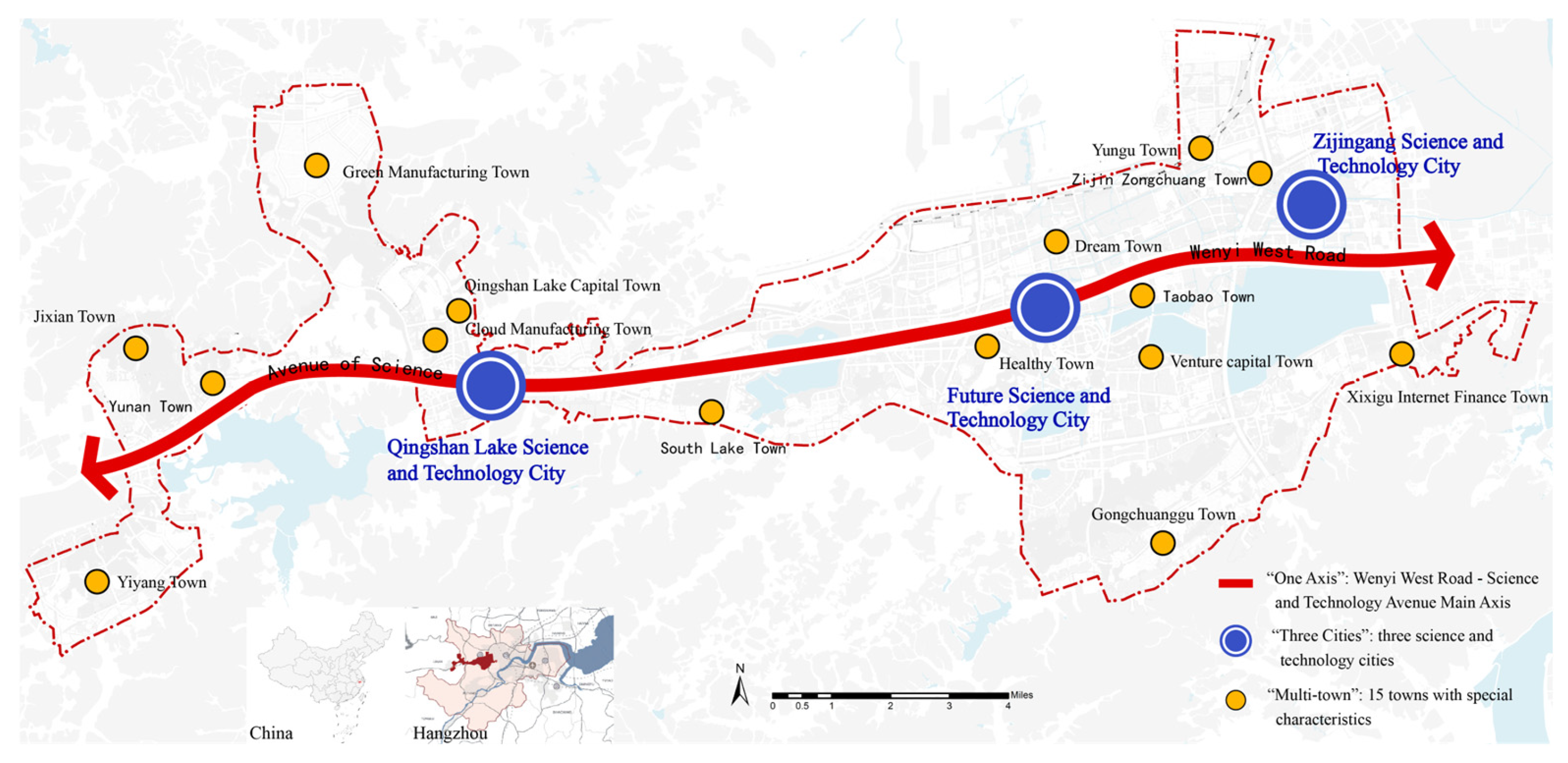
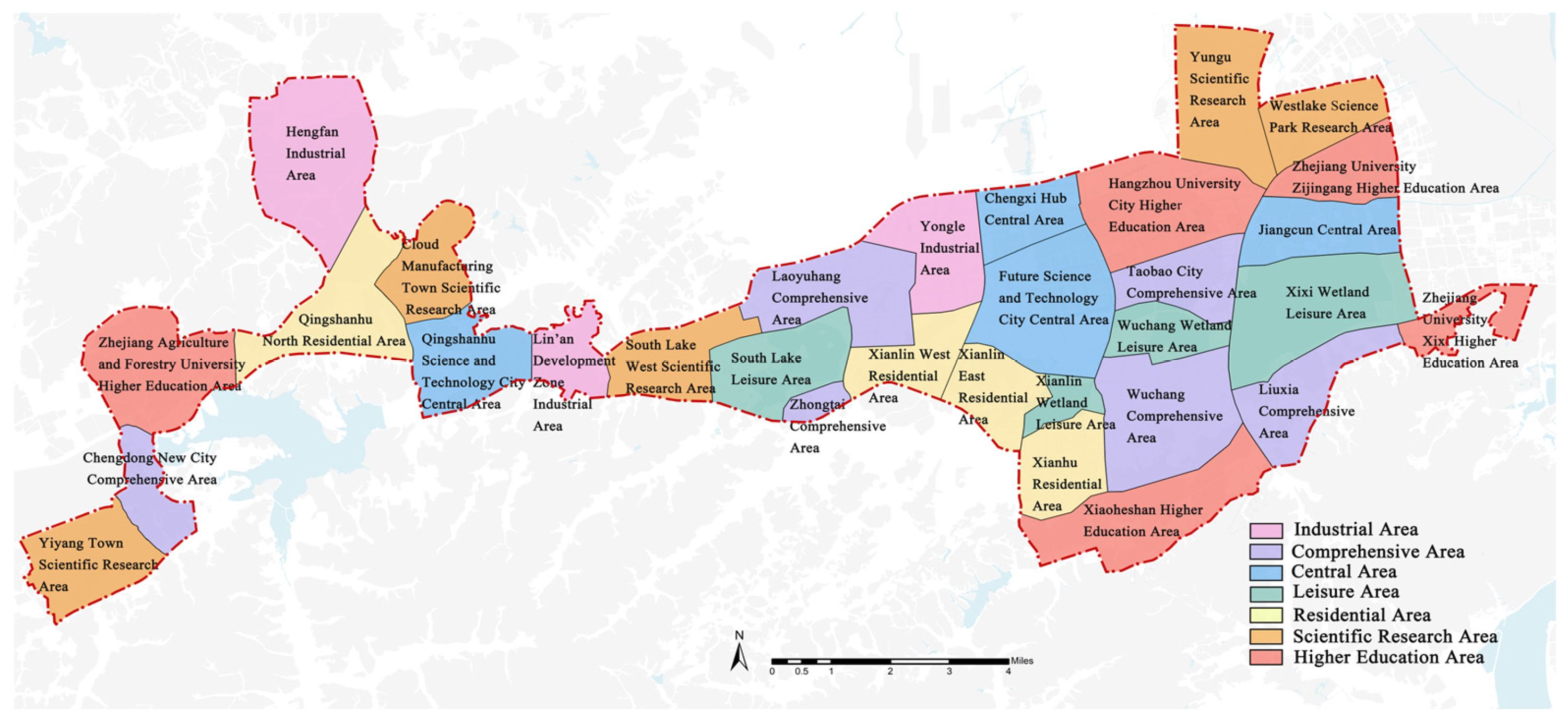
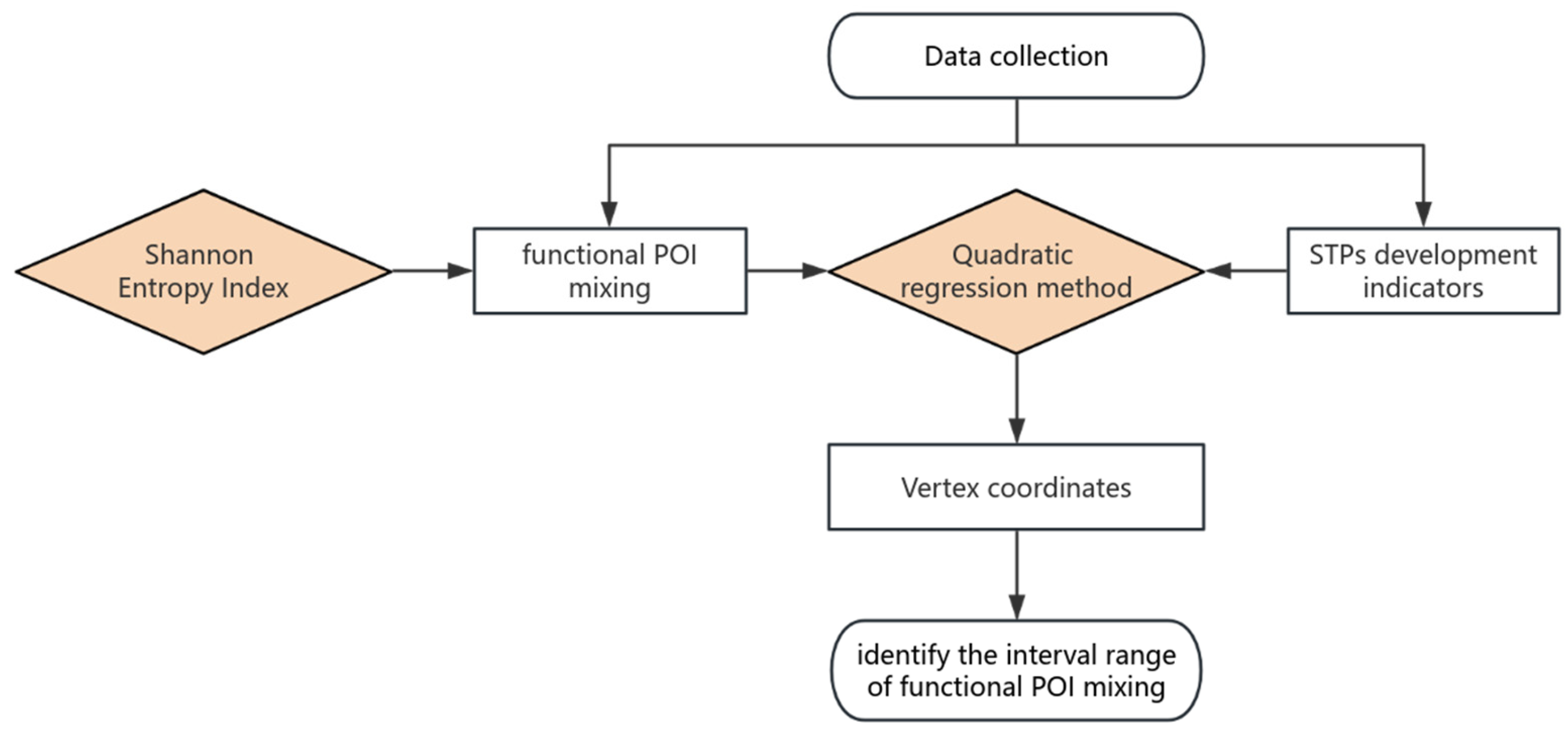
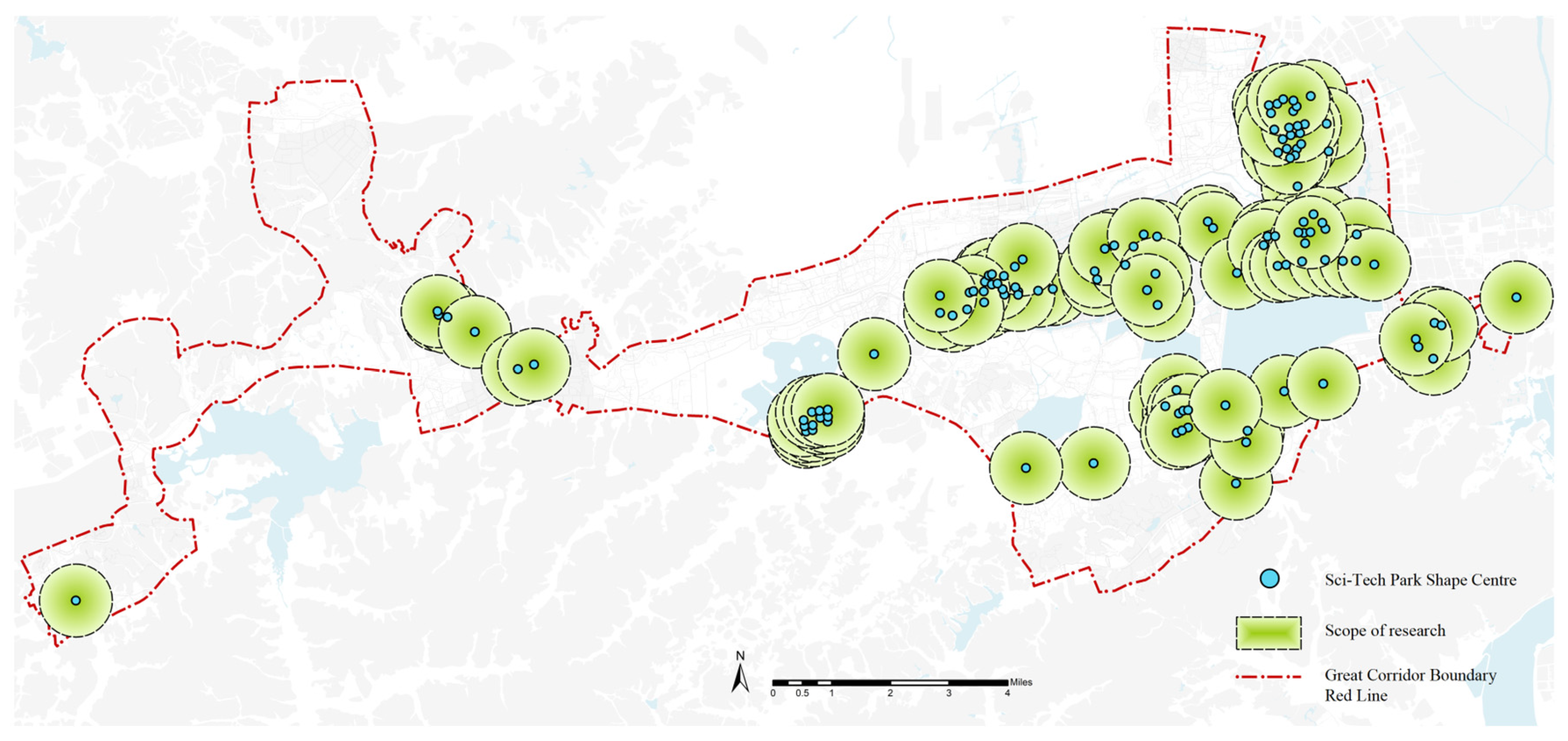
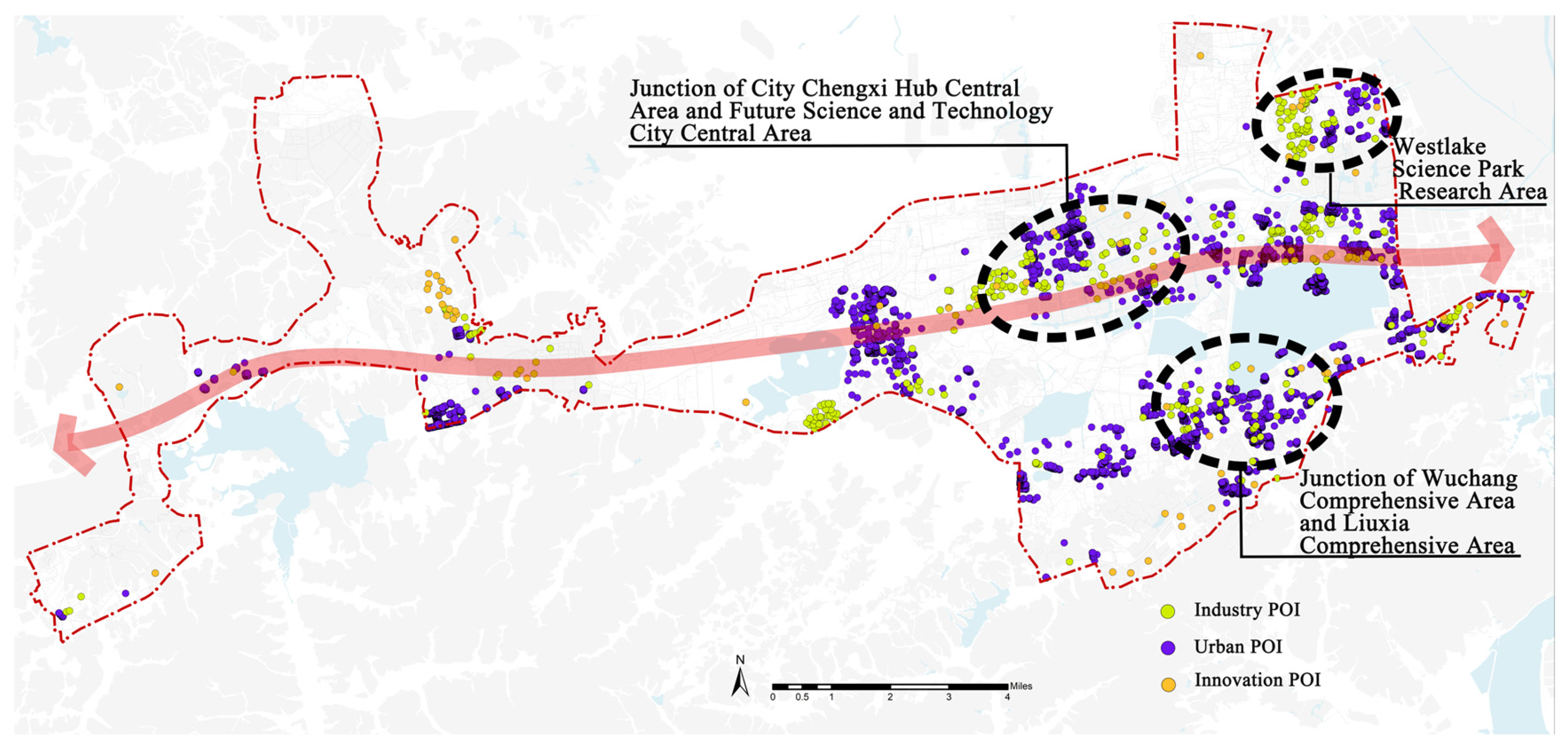

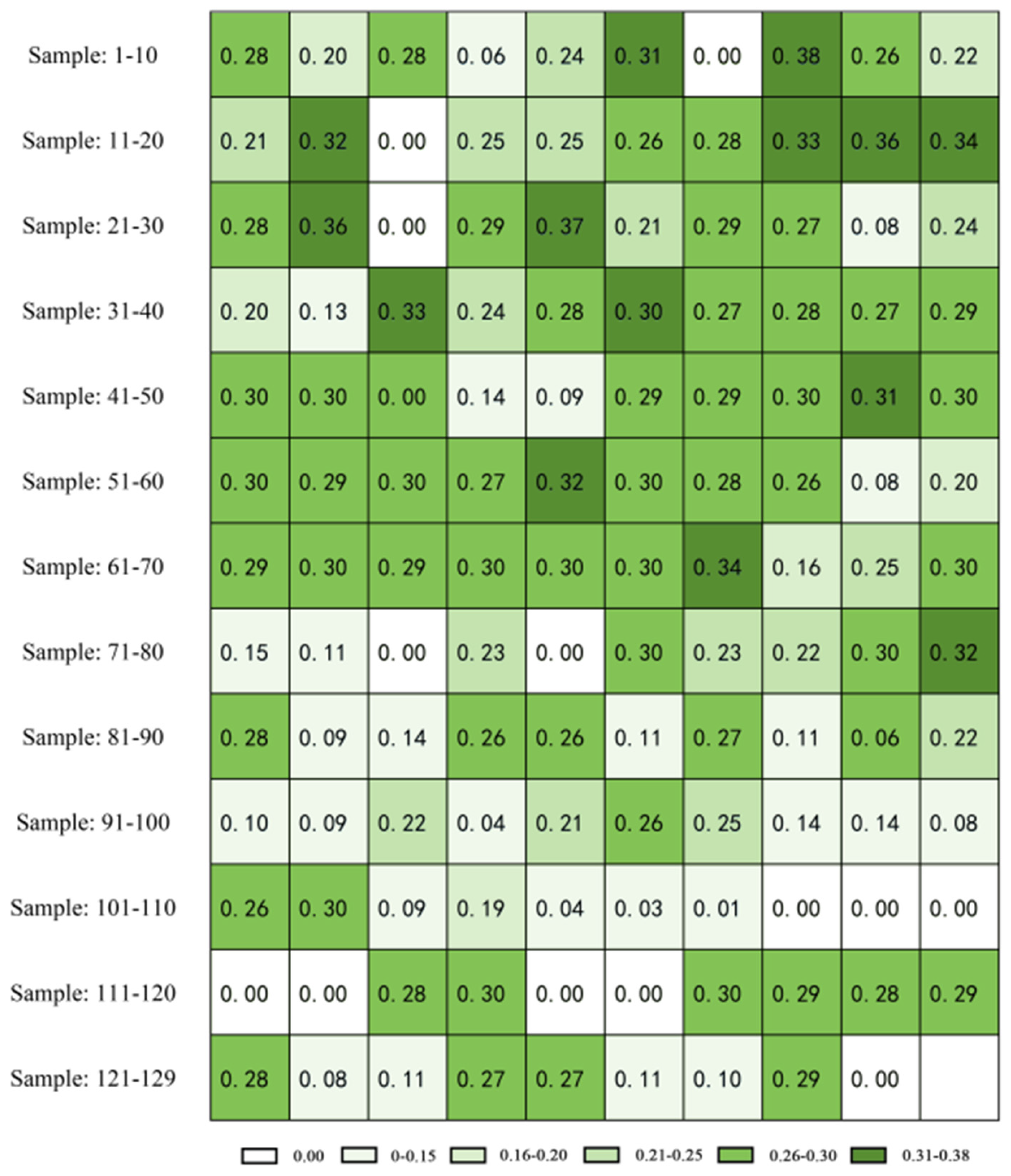
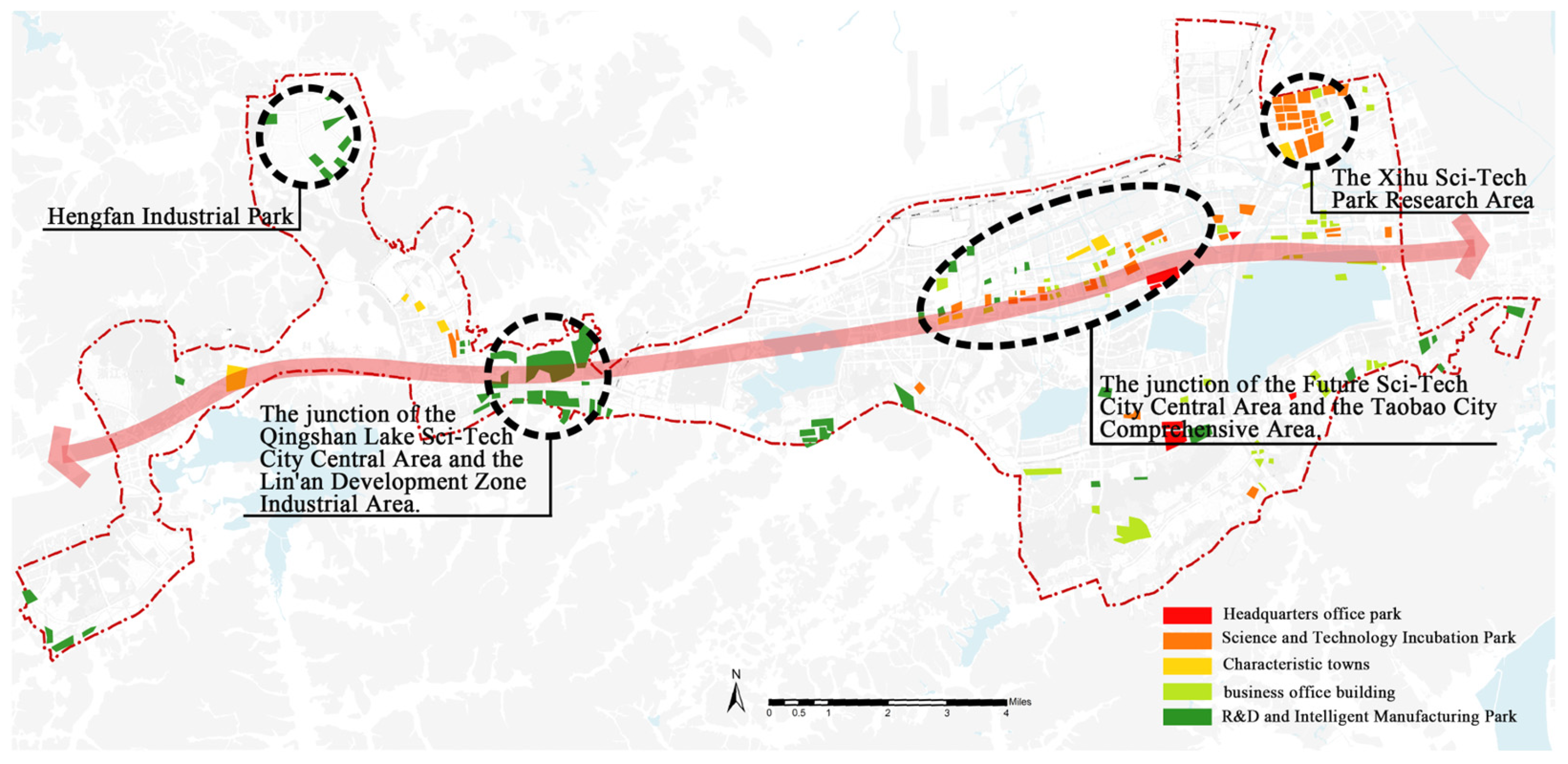

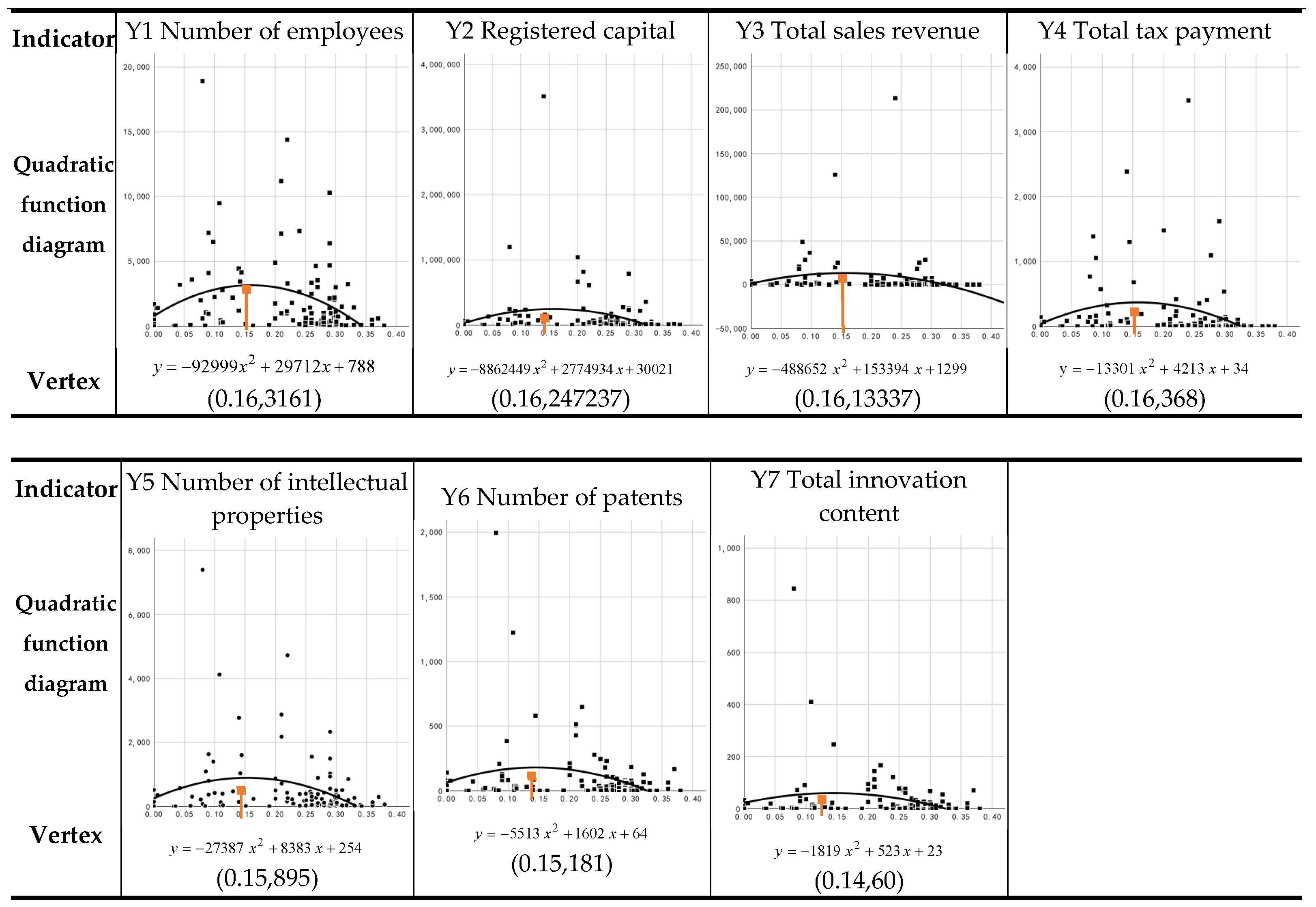

| Dependent Variables | Indicator | Relationship | p-Values |
|---|---|---|---|
| Y1 | Number of employees | Linear/Logarithmic | p = 0.277/p = 0.820 |
| Y2 | Registered capital | Linear/Logarithmic | p = 0.333/p = 0.746 |
| Y3 | Total sales revenue | Linear | p = 0.417 |
| Y4 | Total tax payment | Linear | p = 0.341 |
| Y5 | Number of intellectual properties | Linear | p = 0.169 |
| Y6 | Number of patents | Linear | p = 0.118 |
| Y7 | Total innovation content | Linear | p = 0.146 |
| Indicator | Coefficient | Unstandardized Coefficients | Standardized Coefficients | t | p | |
|---|---|---|---|---|---|---|
| B | Standard Error | Beta | ||||
| Y1 Number of employees | (Constant) | 788.162 | 635.411 | 1.240 | 0.217 | |
| a2 | −92,999.278 | 24,921.676 | −1.251 | −3.732 | 0.000 | |
| b | 29,712.240 | 8694.800 | 1.145 | 3.417 | 0.001 | |
| Formula | Y = −92,999x2 + 29,712x + 788 | |||||
| Y2 Registered capital | (Constant) | 30,021.143 | 80,805.131 | 0.372 | 0.711 | |
| a2 | −8,862,449.393 | 3,169,288.178 | −0.958 | −2.796 | 0.006 | |
| b | 2,774,933.625 | 1,105,717.221 | 0.860 | 2.510 | 0.013 | |
| Formula | Y = −8,862,449x2 + 2,774,934x + 30,021 | |||||
| Y3 Total sales revenue | (Constant) | 1298.666 | 5198.580 | 0.250 | 0.803 | |
| a2 | −488,652.055 | 203,895.451 | −0.829 | −2.397 | 0.018 | |
| b | 153,394.424 | 71,136.072 | 0.746 | 2.156 | 0.033 | |
| Formula | Y = −488,652x2 + 153,394x + 1299 | |||||
| Y4 Total tax payment | (Constant) | 34.003 | 104.434 | 0.326 | 0.745 | |
| a2 | −13,301.390 | 4096.054 | −1.102 | −3.247 | 0.001 | |
| b | 4212.939 | 1429.052 | 1.000 | 2.948 | 0.004 | |
| Formula | Y = −92,999x2 + 29,712x + 788 | |||||
| Y5 Number of intellectual properties | (Constant) | 253.555 | 214.294 | 1.183 | 0.239 | |
| a2 | −27,387.039 | 8404.915 | −1.102 | −3.258 | 0.001 | |
| b | 8382.515 | 2932.349 | 0.967 | 2.859 | 0.005 | |
| Formula | Y = −27,387x2 + 8383x + 254 | |||||
| Y6 Number of patents | (Constant) | 64.228 | 51.766 | 1.241 | 0.217 | |
| a2 | −5512.784 | 2030.335 | −0.927 | −2.715 | 0.008 | |
| b | 1602.020 | 708.353 | 0.772 | 2.262 | 0.025 | |
| Formula | Y = −5513x2 + 1602x + 64 | |||||
| Y7 Total innovation content | (Constant) | 22.583 | 20.121 | 1.122 | 0.264 | |
| a2 | −1818.9600 | 789.192 | −0.794 | −2.305 | 0.023 | |
| b | 22.904 | 275.337 | 0.654 | 1.899 | 0.060 | |
| Formula | Y = −1819x2 + 523x + 23 | |||||
Disclaimer/Publisher’s Note: The statements, opinions and data contained in all publications are solely those of the individual author(s) and contributor(s) and not of MDPI and/or the editor(s). MDPI and/or the editor(s) disclaim responsibility for any injury to people or property resulting from any ideas, methods, instructions or products referred to in the content. |
© 2025 by the authors. Licensee MDPI, Basel, Switzerland. This article is an open access article distributed under the terms and conditions of the Creative Commons Attribution (CC BY) license (https://creativecommons.org/licenses/by/4.0/).
Share and Cite
Yang, Y.; Liu, Y.; Chen, Q.; Du, S. The Influence of “Industry–City–Innovation” Functional Mixing on the Innovative Development of Sci-Tech Parks Under the Background of Urbanization. Sustainability 2025, 17, 3715. https://doi.org/10.3390/su17083715
Yang Y, Liu Y, Chen Q, Du S. The Influence of “Industry–City–Innovation” Functional Mixing on the Innovative Development of Sci-Tech Parks Under the Background of Urbanization. Sustainability. 2025; 17(8):3715. https://doi.org/10.3390/su17083715
Chicago/Turabian StyleYang, Yue, Yidi Liu, Qiujie Chen, and Shaoshan Du. 2025. "The Influence of “Industry–City–Innovation” Functional Mixing on the Innovative Development of Sci-Tech Parks Under the Background of Urbanization" Sustainability 17, no. 8: 3715. https://doi.org/10.3390/su17083715
APA StyleYang, Y., Liu, Y., Chen, Q., & Du, S. (2025). The Influence of “Industry–City–Innovation” Functional Mixing on the Innovative Development of Sci-Tech Parks Under the Background of Urbanization. Sustainability, 17(8), 3715. https://doi.org/10.3390/su17083715





